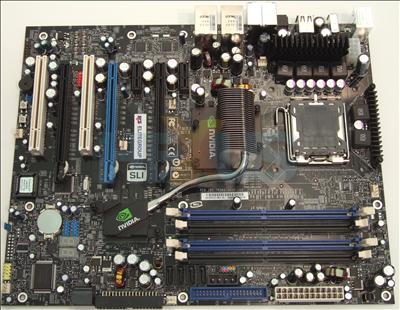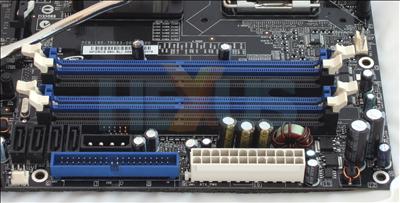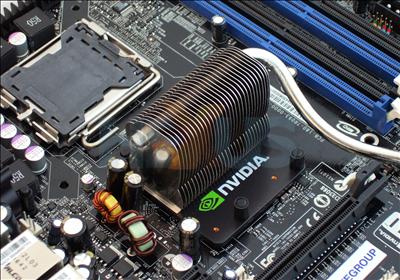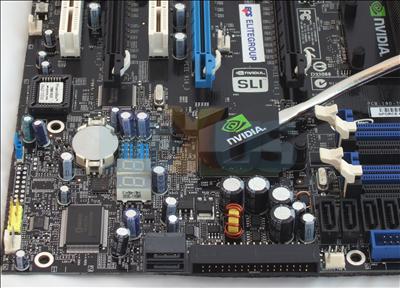Layout and features
There are two approaches when releasing an nForce 680i SLI motherboard. You can choose to purchase the finished board from NVIDIA directly, in all its reference glory, and place your sticker on top and add in something new to the deluxe bundle. The other option is to procure just the chipset from NVIDIA (rumoured to set partners back by around $80 USD) and build your own design with unique features and cooling.ECS, evidently, has gone with the former option and differentiating this board from the others requires a quick glance at the sticker between PEG x16 slots. The reference approach allows companies to bring 'their' SKU to the market quicker than a build-it-yourself approach, and the reference mainboard, manufactured by Flextronics, is excellent in almost every regard, so no complaints here.
The following commentary, then, applies to all reference nForce 680i SLI motherboards. Looking at the bottom-right, NVIDIA's moved 4 of the chipset's 6 SATA2 ports to this location. Makes sense, with powerful (and long-ish) graphics cards expected to populate the PEG x16 slots. There's decent room around the DIMM slots and the power connectors are located nicely, too.
The above shot highlights the clearance around the CPU socket. Being based on LGA775 processors and high-end in nature, the ECS PN2 SLI2+ is compatible with all of Intel's dual- and quad-core CPUs.
The chipset bridges' heatsinks are connected via a heatpipe. NVIDIA advises using a supplied northbridge fan if overclocking, and you can see the attaching screws above. Whilst undoubtedly large, the northbridge heatsink's placement does not impact upon other components.
Moving on down to the bottom-left corner, this enthusiast-class motherboard has a debug LED, useful for troubleshooting, and rotated SATA2 and floppy ports, saving a little extra space and keeping the board's layout, subjectively speaking, top notch.
The low-profile southbridge heatsink won't impede aforementioned cards from proper fitment. There are numerous fan headers and PCB-based power and reset buttons, which make sense on a board that most prospective buyers will want to push to the limit. FireWire400 support is provided by a Texas Instruments ASIC, located directly underneath the PCIe x16 (2) slot on the far left and just to the right of the BIOS chip.
Flipping the board around, the PN2 SLI+2 is equipped with a trio of mechanical x16 PCIe slots. The black-coloured pair can be coupled up to enable SLI; NVIDIA's multi-GPU technology. Both run at x16, electrically, so provide full bandwidth to the requisite cards. The third slot, coloured blue, provides an electrical x8 connection and can be used for either extending the display options present or, for you gamers out there, as an additional slot into which you may install a card utilised for physics acceleration, if supported. Presently, though, NVIDIA's drivers don't support a third PCIe card running game physics.
A couple of conventional PCI and PCIe x1 expansion ports make up the board's 7-slot configuration, although you'll lose one of each if a couple of double-height graphics cards are used.
Two Marvell PCIe ASICs cover the chipset's dual GigE support, which can be teamed up (DualNet) for a super-fast connection to multiple clients. Rounding off the hardware is Realtek's ALC885 HD Codec, which uses the chipset's HD Audio and feeds it into the outputs on the I/O section. We'd like to have seen the Realtek ALC885M-GR codec used instead, as it provides additional support for Dolby Digital Live and Master Studio support, but that's one of the downsides with ECS buying in a fixed-specification motherboard from NVIDIA and one reason why some motherboard manufacturers prefer to architect their own layout and features.
All pretty standard fare at the back. NVIDIA's decided to stick with optical S/PDIF-out, yet it would have been nice to see coaxial get a look-in, too.
Thinking of the reference nForce 680i SLI's layout with respect to the enthusiast, there's very little wrong with it. Intelligent port placement and considered ASIC layout are hallmarks of good design and this board has them both. ECS naturally benefits from running with the reference model and, as we noted in our eVGA review, we have little to criticise on this front.















